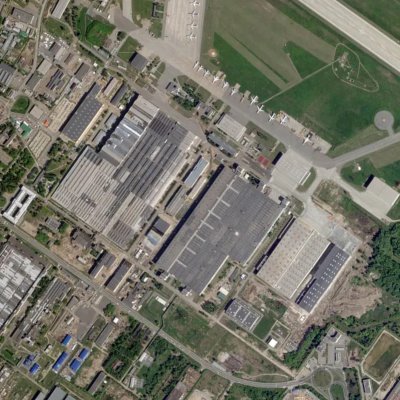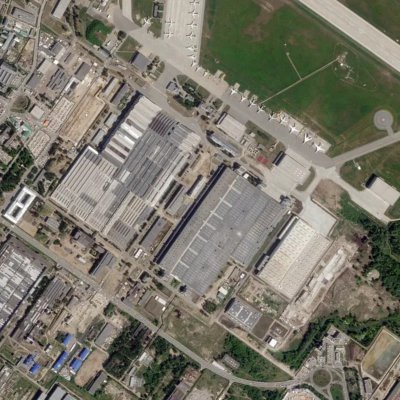Russia’s ambitions to produce more military aircraft are being thwarted by a shortage of components caused by sanctions and a growing labor shortage, it has been reported.
Satellite images shared with Newsweek by Earth imaging company Planet Labs show the expansion of the Kazan Aviation Plant in Russia’s republic of Tatarstan over the last year.
The site is said to be the only location with the capacity to replace the 40 military aircraft Kyiv said were damaged or destroyed in June’s daring Operation Spiderweb drone attacks that targeted planes which can launch cruise missiles.
But a shortage of workers and components has hampered production, according to think tank the Institute for the Study of War (ISW).
Oliver Ruth, an intelligence analyst who focuses on the war in Ukraine, told Newsweek sanctions had in the short to medium term “crippled” Russia’s production capabilities for planes like strategic bombers.
Newsweek has contacted the Russian defense ministry for comment.
Why It Matters
Kyiv said its Operation Spiderweb drone attacks in June destroyed a large number of Russian military aircraft critical for Moscow’s aggression in its full-scale invasion of Ukraine, although Moscow has played down the impact of the strikes.
However, Russia’s military aircraft production in Kazan faces growing obstacles of worker shortages and components for such a program, suggesting Moscow faces problems maintaining its aviation capabilities.
What To Know
Finnish outlet Yle first reported how satellite images taken between mid-2024 and May 2025 from Planet Labs, and later provided to Newsweek, showed the construction and expansion of at least five buildings at the Kazan site.
Russia is expanding its aircraft plant in Kazan, where it produces bombers, according to Finnish broadcaster Yle. Analysts report that several new buildings have appeared on the site, with a total area roughly equal to three football fields. The expansion is expected to be… pic.twitter.com/ktFb36LjiA
— WarTranslated (@wartranslated) June 28, 2025
The site makes and maintains Russian strategic aircraft such as the Tupolev Tu-160M, Tu-160M2, and Tu-22M3, as well as helicopters and civilian aircraft.
In January plans were announced for the Kazan plant to produce four Tu-214 airliners in 2025, seven in 2026, 17 in 2027 and 28 in 2028.
Military expert Marko Eklund, who analyzed the images obtained by Yle, told the Finnish outlet that the new production space would not solve the problems faced by Russia’s aviation industry.
So far, production is slow and in 2024 only two Tu-160M2 and two Tu-160M— which have launched cruise missiles in Ukraine—have been commissioned.
The ISW said that the plant’s annual production rate is unclear as these Tupolevs were probably under construction for some time.
The think tank concluded that sanctions and parts and labor shortages will likely continue to slow Russia’s aircraft production.
Intelligence analyst Ruth told Newsweek that components and logistics from neighboring countries into Russia have “slowed to a crawl.”
“It was already hard for them to procure a lot of what they needed, but now that’s been slowed even further through security considerations— they don’t want to sacrifice more bombers,” he said.
Ruth said that because of sanctions, Russia cannot really achieve the economies of scales needed to reach earlier production commitments.

Planet Labs PBC

Planet Labs PBC

Planet Labs
Ukrainian news outlet Militarnyi had previously reported that the Russian United Aircraft Corporation had revamped three workshops for new Tu-160 bombers.
The country’s largest military aviation contractor United Aircraft Corporation wants to boost production of Sukhoi fighter jets by 30 percent at the same time as firing 1,500 management staff, according to the ISW.
But despite the claims by UAC Head Vadim Badekha, Russia can currently produce only one such aircraft every one to two months, according to Ukrainian military observer Oleksandr Kovalenko.
The ISW said that the firing of staff may be a result of the Kremlin deprioritizing the aircraft industry to conserve funds and materials for drone and weapons production amid ballooning military spending.
What People Are Saying
The Institute for the Study of War (ISW) said on June 29: “Sanctions and parts and labor shortages will likely continue to slow Russia’s aircraft production, even as Russia works to expand physical production capabilities.”
Military expert Marko Eklund per Yle: “Russia would like to look equal to the United States, but the production of old bomber models says a lot about its capabilities.”
Oliver Ruth, intelligence analyst, told Newsweek: “Because of sanctions, Russia can’t achieve the economies of scales needed to reach those earlier commitments of production.
“It’s a compounding issue, especially because a lot of the production plants and the expertise to produce these airframes just haven’t existed in some cases for decades.”
What Happens Next
After a huge increase in military spending, President Vladimir Putin has announced that Russia was looking to cut its military expenditure from next year.
While the comments will be greeted with skepticism in the West, growing military costs and a turbulent sanctions-hit economy mean questions remain about Russia’s ability to maintain its air capability in the war. Ruth predicted that in the longer term, Russia was likely to pivot away from the use of strategic bombers.
The post Russia Is Struggling To Build Warplanes appeared first on Newsweek.




